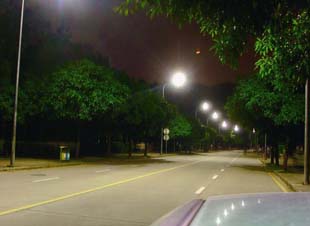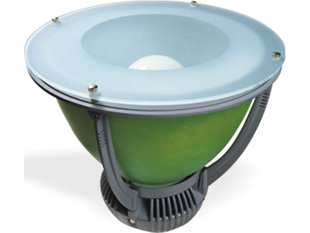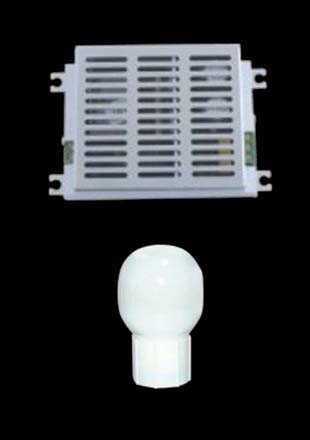“Green” Lighting Takes Off in Southern China
2008/04/07 | By Philip LiuWith soaring oil prices having made energy conservation a hot topic all over the world, electrodeless discharge lamps have emerged as new star products, along with light-emitting diode (LED) lamps, in the lighting market.
While the application of LED lamps has become increasingly widespread in the past few years, electrodeless discharge lamps have been confined to commercial use until more recently. Now they too are spreading rapidly, thanks to breakthroughs in the suppliers of parts and components.

With no filaments or electrodes, electrodeless discharge lamps function on the principle of magnetic induction and gas-discharged electricity (the latter of which is similar to the function of a fluorescent lamp). Electrodeless discharge lamps have numerous advantages compared with traditional lights, including long life (50,000-100,000 hours, 50 times that of incandescent lamps, 10 times that of halogen lamps, and even longer than LED lamps). In addition, electrodeless discharge lamps cost only about 30% as much as LED lamps.
Furthermore, electrodeless discharge lamps offer electricity savings of more than 80% compared with incandescent lamps and 30-40% compared with halogen lamps, thanks to their high efficiency. They can generate 65 lm/w, compared with just 15 lm/w for incandescent lamps and 40-50 lm/w for halogen lamps.
Another advantage of electrodeless discharge lamps is that they solid amalgam they use is almost 100% recyclable. They also have the advantages of low glare, lack of flickering, excellent color rendition, and the ability to be switched off and back on instantly.
These new light sources are divided into two types: low-frequency (2 KHz) with external coupler, and high-frequency (2 MHz) with built-in coupler. The high-frequency models that many manufacturers in southern China have started to make are suited for use in schools, factories, tunnels, and gymnasiums.
Huge Market Potential Attracts Manufacturers
The market potential for these and other power-saving lamps is tremendous, both in China and elsewhere. In April last year, for example, the Chinese government announced plans to install 50 million high-efficiency energy-saving lamps throughout the country; this will result in substantial energy savings, since lighting accounts for 10-12% of China's total power consumption. Such policies are also appearing in other places, including the European Union, the United States, Australia, and Japan, where incandescent lamps are to be banned in the not-too-distant future.
Throughout the world, lighting accounts for 19% of power consumption. According to the U.S. Department of Energy, a 10% reduction in global lighting-related power consumption would lead to a saving of US$100 billion worth of power consumption and US$50 billion worth of power-plant construction by 2025.
Following are profiles of some of Southern China's high-frequency electrodeless discharge lamp makers:
Shenzhen Green Light Electronics Technology, located in the Shenzhen Hi-Tech Industrial Park, was founded in December 2000 and boasts an R&D team with scores of members. It owns several Chinese patents for its electrodeless discharge lamps.
"Our electrodeless discharge lamps feature little heat generation and fast heat dissipation, thanks to our patented coupler and high-frequency generator, which boosts their lighting efficiency and prolongs their life," comments Chen Yujia, the company's general manager. He says that his products were given an outstanding power-saving design award by the Shenzhen city government in 2004 and achieved China Quality Guarantee Center (COGC) certification in 2005.
Many government agencies, as well as domestic and foreign companies (POSCO of South Korea, Shanghai Pudong Airport, and Foxconn, among others), have adopted his lamps, Chen reports: "The Shenzhen city government installed our electrodeless discharge lamps on Longwei Road in August 2007, and achieved a power saving of 77%."
Some 80% of the firm's output is sold in the domestic market, with the remaining 20% exported, mainly to South Korea.
The Shenzhen Sunlight Lighting Technology Co. was founded in 2006 by general manager Dongyi Chen, who was attracted by the huge potential of electrodeless discharge lamps and abandoned a long career in foreign trade. "Our lamps feature a one-piece body," Chen reports. "This makes them very convenient to use--unlike the electrodeless discharge lamps made by Philips and Osram, which have separate electric circuits and PU foam parts."
The company's high-frequency lamps can fit easily into ordinary lighting fixtures, thanks to the architecture of their built-in couplers. Its lamps carry a price of only 400 renminbi, a fraction of the US$300 commanded by some foreign brands.

Mass Production for Low Prices
Mass production helps to keep the company's prices down. Its target this year is 150,000 units, up five-fold from 2007. "Mass production enables us to produce our PU foam parts in-house, which helps cut production costs and also enhances product quality," Chen comments.
Shenzhen Sunlight Lighting Technology also makes its own high-frequency generators, which are key components of electrodeless discharge lamps. Its generators boast a power factor of 0.99, compared to 0.95 for most other generators available on the market. "We are one of the few Chinese manufacturers in this line with an integrated production line," Chen claims, "and this has promoted several foreign companies, including one in South Korea, to move to establish cooperative links with us."
The company's lamps have a frequency of up to 2.65 MHz, a lighting efficiency of 70 lm/w, and a maximum power factor of 200w. It is now developing models with a frequency of 13.5 MHz which, according to Chen, will be able to boost lighting efficiency to 150 lm/w.
Most of the company's products are sold in the domestic market, with some exports going to such countries as Singapore and South Korea.
The Jinrongda Lighting Co. turns out fluorescent and other power-saving lamps in addition to high-frequency electrodeless discharge lamps. Its marketing consultant, Tong Zonghua, says that the company is strong in R&D as evidenced by its second production line. "Our new production line for PU-foam parts has self-developed equipment and will begin operating in May," Tong explains, adding that the new production capacity will boost the company's output of electrodeless discharge lamps by 20% this year (from 210,000 units in 2007).

"This new production line will help us not only to cut production costs, but also to enhance our quality," Tong remarks.
The company also operates a production line for ballasts, another component that is critical to the quality of lighting products. Its electrodeless discharge lamps have passed 3C and CE certification, and it is now applying for ISO certification.
Most of Jinrongda Lighting's products are sold on the domestic market; the company has begun exploring overseas markets, however, notably in Southeast Asia. (PL, March 2008)




